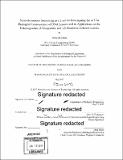| dc.contributor.advisor | John M. Essigmann. | en_US |
| dc.contributor.author | Chang, Shiou-chi, Ph. D. Massachusetts Institute of Technology | en_US |
| dc.contributor.other | Massachusetts Institute of Technology. Department of Biological Engineering. | en_US |
| dc.date.accessioned | 2017-12-05T19:15:28Z | |
| dc.date.available | 2017-12-05T19:15:28Z | |
| dc.date.copyright | 2017 | en_US |
| dc.date.issued | 2017 | en_US |
| dc.identifier.uri | http://hdl.handle.net/1721.1/112497 | |
| dc.description | Thesis: Ph. D., Massachusetts Institute of Technology, Department of Biological Engineering, 2017. | en_US |
| dc.description | Cataloged from PDF version of thesis. | en_US |
| dc.description | Includes bibliographical references. | en_US |
| dc.description.abstract | DNA damaging agents produce a plethora of DNA lesions, which can lead to various outcomes. In order to understand the biological consequences of DNA lesions, and hence gain insights into the carcinogenic mechanisms of DNA damaging agents, individual lesions need to be evaluated for their genotoxic and mutagenic potentials in cells. In this work, we devised and validated a new strategy to study the in vivo consequences of DNA lesions using next-generation sequencing. By labeling different samples with unique oligonucleotide sequences as barcodes, multiple lesions can be simultaneously evaluated in multiple cell strains with different repair and replication capabilities. This high-throughput, multiplex approach greatly relieves the burden on researchers, and reduces the time and cost for a large-scale investigation. We applied this methodology to the investigation of ethenoguanine lesions, which are generated by oxidative stress and vinyl chloride exposure. N²,3-Ethenoguanine potently induces G to A mutations, the same type of mutation previously observed in vinyl chloride-associated tumors. We also found that N²,3-ethenoguanine cannot be repaired by AlkB, a DNA repair enzyme capable of repairing all other etheno lesions. Our observations suggest this lesion may have a functional role in vinyl chloride-induced or inflammation-driven carcinogenesis. The in vivo genotoxicity and mutagenicity of four 1,3-butadiene-induced adenine adducts were evaluated. Previous in vitro studies have shown that some of these lesions are highly mutagenic. Surprisingly, we found that none of them was significantly mutagenic in any of the conditions investigated. This observation suggests that there may be unknown mechanisms mitigating the mutagenic effect of the butadiene-induced lesions. Finally, we extended our methodology one step further by simultaneously analyzing the mutagenicity of 8-oxoguanine, a prevalent oxidative lesion, in all 16 adjacent-base sequence contexts. Our result shows that sequence context can significantly modulate 8-oxoguanine mutagenicity. The observed 8-oxoguanine mutational pattern clustered closely with COSMIC (Catalogue of Somatic Mutation in Cancer) Signature 18 of human cancers, providing support that this signature may result from oxidative damage. By applying the same type of analysis to other DNA lesions, researchers may identify the underlying processes that are responsible for the human cancer mutational signatures with unknown etiologies. | en_US |
| dc.description.statementofresponsibility | by Shiou-chi Chang. | en_US |
| dc.format.extent | 164 pages | en_US |
| dc.language.iso | eng | en_US |
| dc.publisher | Massachusetts Institute of Technology | en_US |
| dc.rights | MIT theses are protected by copyright. They may be viewed, downloaded, or printed from this source but further reproduction or distribution in any format is prohibited without written permission. | en_US |
| dc.rights.uri | http://dspace.mit.edu/handle/1721.1/7582 | en_US |
| dc.subject | Biological Engineering. | en_US |
| dc.title | Next-generation sequencing as a tool for investigating the in vivo biological consequences of DNA lesions and its applications on the ethenoguanine, 8-oxoguanine and 1,3-butadiene-induced lesions | en_US |
| dc.type | Thesis | en_US |
| dc.description.degree | Ph. D. | en_US |
| dc.contributor.department | Massachusetts Institute of Technology. Department of Biological Engineering | |
| dc.identifier.oclc | 1011520391 | en_US |
